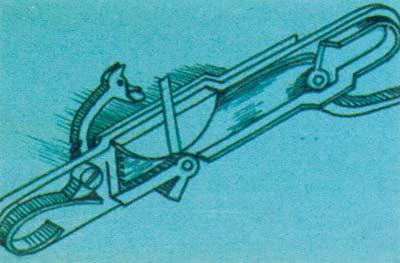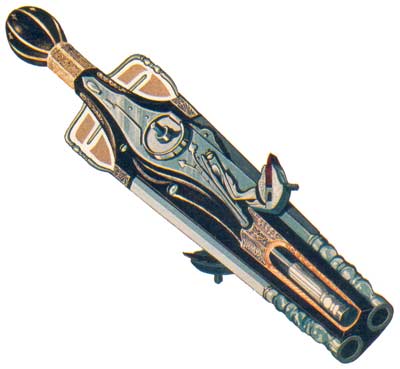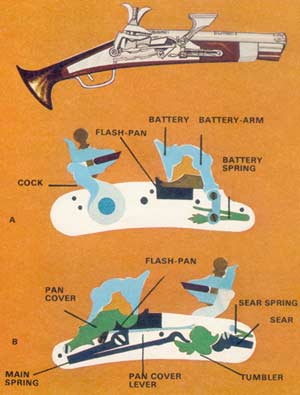|
Serpentines and Matchlocks
 The
makers of early hand-guns, having furnished a means of holding
the weapon by fitting wooden stocks, were still faced with
the problem of ignition. Using a red-hot iron or wire, or
burning tinder, to set off the priming powder made it necessary
to have a fire or brazier near at hand. The
makers of early hand-guns, having furnished a means of holding
the weapon by fitting wooden stocks, were still faced with
the problem of ignition. Using a red-hot iron or wire, or
burning tinder, to set off the priming powder made it necessary
to have a fire or brazier near at hand.
Shown here is a musketeer, early 17th
century. The musket of the period was an unwieldy weapon,
weighing some 20lb. It was fired from a rest consisting
of a wooden rod topped with a metal fork. Also shown is
the matchlock system of ignition.
Late in the 14th century came a solution
to this difficulty, with the invention of the slow match.
Saltpetre (potassium nitrate), one of the ingredients of
gunpowder, was dissolved in water. Lengths of tow, were
soaked in the solution and allowed to dry, would smoulder
slowly when lit. This match gave the gunner greater freedom
movement.
It remained a difficult task, however,
to apply this match to the touch-hole in the heat of battle;
and more effective marksmanship would obviously be possible
with two hands free to manipulate the gun. So a system of
ignition was devised with an S-shaped piece metal, called
the "serpentine" or "cock", attached
to the side of the gun. The match was held in its upper
end, and the serpentine pivoted to lower the match into
the priming pan.
This system soon developed into the
matchlock mechanism. In this the cock was held clear of
the priming pan by a spring. To fire the gun, the spring
was released by means of a trigger action
The Wheel-Lock
We have seen the advantage gained by
replacing the old hand ignition system for guns by the matchlock.
But gun-makers were always on the look-out for improvements.
The fact that flint and other minerals could be used to
produce sparks had been known from early times. It was this
knowledge which led to the introduction, about the end of
the 15th century, of what is called the wheel-lock.
A sketch of a wheel-lock mechanism
is included in the Codex Atlanticus of Leonardo da Vinci,
the Italian artist, scientist and inventor of that period.
It is not known, however, whether it was his own design,
or copied from an existing wheel-lock.
 The
wheel-lock works very much like a modern flint lighter.
The priming pan is on the side of the gun and a toothed
wheel is situated below, with its top edge protruding through
a slot into the pan. The wheel is rotated by a spring, which
is wound up with a key. In front of the pan is the cock,
or "dog-head", holding a piece of iron pyrites. The
wheel-lock works very much like a modern flint lighter.
The priming pan is on the side of the gun and a toothed
wheel is situated below, with its top edge protruding through
a slot into the pan. The wheel is rotated by a spring, which
is wound up with a key. In front of the pan is the cock,
or "dog-head", holding a piece of iron pyrites.
When the trigger is pressed, the wheel-spring
is released and the cock pivoted down to bring the pyrites
into contact with the teeth of the rotating wheel. The resultant
sparks ignite the powder in the pan.
Though the principle is simple, the
mechanism is in fact very intricate, and may have as many
as 50 components. The main advantage of the wheel-lock was
that it enabled the user to have his weapon ready for firing
at any time. This had not been possible with the matchlock,
since the match would smoulder for an indefinite period.
The danger of accidental discharge was also reduced.
Roman Candle Guns
Having invented the wheel-lock, the
gun-maker next turned his hand to designing guns that could
fire two or more rounds without reloading.
 The
obvious answer to this need was to make guns with two or
more barrels, and a lock for each barrel. Many weapons were
designed on these lines, including the German 16th century
gun illustrated here. It has two barrels one above the other;
each barrel has its own wheel-lock. The
obvious answer to this need was to make guns with two or
more barrels, and a lock for each barrel. Many weapons were
designed on these lines, including the German 16th century
gun illustrated here. It has two barrels one above the other;
each barrel has its own wheel-lock.
In another system two or more charges
of powder and ball were loaded in a single barrel, separated
by wads. These were fired in turn, starting from the front
or muzzle end, through a succession of touch-holes, each
ignited by a separate lock.
A development of this was the Roman
Candle gun. The bullets used in this had holes drilled through
them, filled with powder. It was only necessary to fire
the front charge to set going a powder-train through the
barrel.
A more complicated form of Roman Candle
gun is the 17th century pistol shown. It has four barrels.
The first is loaded with one round of powder and shot in
the normal way; the second with powder only; the third and
fourth with a number of bullet and powder charges. When
the first barrel is discharged by means of its wheel-lock,
it ignites the powder in the second through a touch-hole
towards the muzzle. The second barrel is linked alternately
to the third and fourth barrels by a row of touch holes.
As its powder burns backwards, it sets off these charges
one by one. With all such weapons, the discharge, once started,
cannot be stopped.
The Snaphaunce
About the time when the wheel-lock
was coming into general use, or certainly not long afterwards,
yet another form of ignition for guns was introduced. Instead
of iron pyrites subjected to friction against a revolving
steel wheel, it used flint struck against steel to produce
a spark.
 These
guns may be called the first of the flintlocks; but for
convenience of classification they are nowadays generally
termed "snaphaunce" guns, to distinguish them
from the more sophisticated forms of flintlock introduced
in the 17th century. These
guns may be called the first of the flintlocks; but for
convenience of classification they are nowadays generally
termed "snaphaunce" guns, to distinguish them
from the more sophisticated forms of flintlock introduced
in the 17th century.
The snaphaunce gets its name from the
Flemish schnapp-hahn, "pecking cock". This refers
to the action of the cock which holds the flint. Unlike
the dog-head in most wheel-lock weapons, the cock was situated
behind the priming pan (also called the flash-pan). In other
respects its action was similar. The steel (known as the
"battery") was on an arm pivoting over the priming
pan from the front.
Pressure on the trigger resulted in
the following movements: (1) A lever action opened the sliding
cover of the flash-pan. (2) The battery pivoted backward
over the pan. (3) The cock pivoted forward so that the flint
struck the battery and produced the spark.
The battery-arm bore on an exterior
spring in such a way that it could be retained in the "safe"
position, forward of the pan, if required. The cock could
not then cause a spark if accidentally released.
Our illustration shows a fine example
of the snaphaunce. It is a late 16th century German pistol.
The diagrams show (A) the exterior and (B) the interior
mechanism of a typical snaphaunce.
The Cap
One of the drawbacks of early methods
of firing a gun was the "hangfire". This was the
delay between igniting the priming and the firing of the
main charge. To obtain instantaneous discharge it was necessary
to find a faster means of ignition.
At the beginning of the 19th century,
a Scottish clergyman named Alexander Forsyth produced a
solution to the problem. It was known that the chemical
compounds called fulminates would explode when struck. Forsyth
devised a method of using fulminate of mercury for firing
a gun. His lock had a hammer instead of the cock of the
flintlock. A hollow plug was screwed into the touch-hole.
Pivoting on the side of the gun was a magazine, shaped like
a scent-bottle, containing the detonating powder.
When the "scent-bottle" was
turned it dropped a small quantity of the fulminate into
the plug. The trigger released the hammer, which drove a
firing-pin into fulminate.
Various
improvements followed, but the one which gained general
acceptance was the percussion cap, illustrated here. It
was generally made of copper, and shaped like a hat, with
the fulminate in the "crown". The cap was placed
over an iron nipple which was screwed into the breach of
the gun. When the hammer fell, it crushed the cap against
the top of the nipple, exploding the fulminate and firing
the powder through the hole in the nipple. The hammer was
hollowed out so that it entirely enclosed the percussion
cap. As in the pocket pistol illustrated, hammers were later
mounted centrally on top of the gun, instead of at the side.
- Article lifted from an old series of magazines published between 1970 and 1975 by IPC Magazines, called 'World of Wonder'.
|


 The
makers of early hand-guns, having furnished a means of holding
the weapon by fitting wooden stocks, were still faced with
the problem of ignition. Using a red-hot iron or wire, or
burning tinder, to set off the priming powder made it necessary
to have a fire or brazier near at hand.
The
makers of early hand-guns, having furnished a means of holding
the weapon by fitting wooden stocks, were still faced with
the problem of ignition. Using a red-hot iron or wire, or
burning tinder, to set off the priming powder made it necessary
to have a fire or brazier near at hand.
 The
wheel-lock works very much like a modern flint lighter.
The priming pan is on the side of the gun and a toothed
wheel is situated below, with its top edge protruding through
a slot into the pan. The wheel is rotated by a spring, which
is wound up with a key. In front of the pan is the cock,
or "dog-head", holding a piece of iron pyrites.
The
wheel-lock works very much like a modern flint lighter.
The priming pan is on the side of the gun and a toothed
wheel is situated below, with its top edge protruding through
a slot into the pan. The wheel is rotated by a spring, which
is wound up with a key. In front of the pan is the cock,
or "dog-head", holding a piece of iron pyrites.
 The
obvious answer to this need was to make guns with two or
more barrels, and a lock for each barrel. Many weapons were
designed on these lines, including the German 16th century
gun illustrated here. It has two barrels one above the other;
each barrel has its own wheel-lock.
The
obvious answer to this need was to make guns with two or
more barrels, and a lock for each barrel. Many weapons were
designed on these lines, including the German 16th century
gun illustrated here. It has two barrels one above the other;
each barrel has its own wheel-lock.
 These
guns may be called the first of the flintlocks; but for
convenience of classification they are nowadays generally
termed "snaphaunce" guns, to distinguish them
from the more sophisticated forms of flintlock introduced
in the 17th century.
These
guns may be called the first of the flintlocks; but for
convenience of classification they are nowadays generally
termed "snaphaunce" guns, to distinguish them
from the more sophisticated forms of flintlock introduced
in the 17th century.